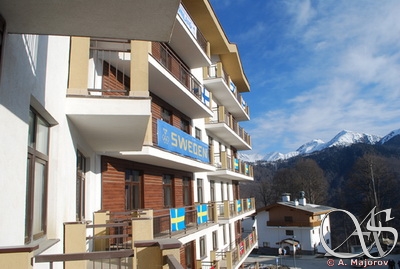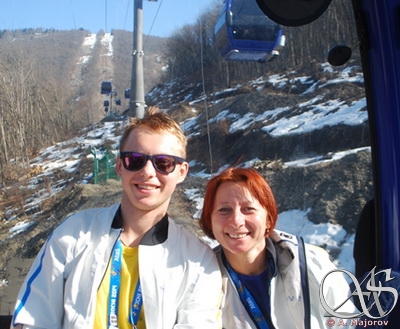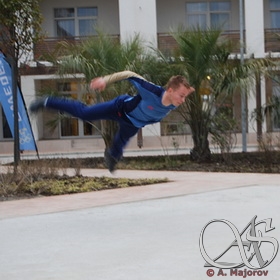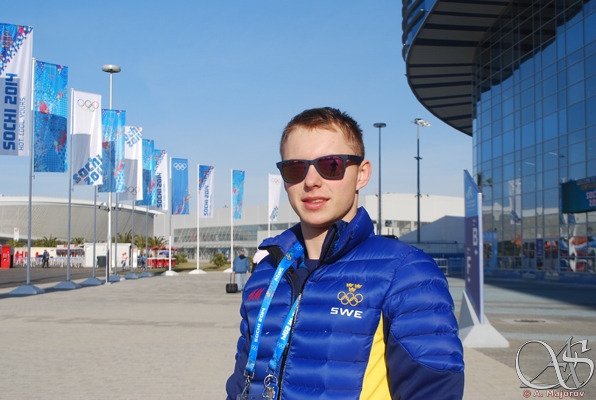Memories of Sochi and things to come for Alexander Majorov
March 25, 2014
By Eva Maria Jangbro (EMJO)
Photos © Alexander Majorov, Eva Maria Jangbro (EMJO)
 Participating in his first Olympic Games, Sweden’s Alexander Majorov was not only armed with his competitive spirit, but also with a camera to catch just about everything around the games. He brought home around 400 photos along with the best experience of his life. I had a chat with him during Art on Ice Stockholm, where he showed me some of his photos, but also talked about how he will progress from here skating wise. We started by looking at some of the photos to bring back the memories of Sochi 2014.
Participating in his first Olympic Games, Sweden’s Alexander Majorov was not only armed with his competitive spirit, but also with a camera to catch just about everything around the games. He brought home around 400 photos along with the best experience of his life. I had a chat with him during Art on Ice Stockholm, where he showed me some of his photos, but also talked about how he will progress from here skating wise. We started by looking at some of the photos to bring back the memories of Sochi 2014.
About the Olympic village and the Swedish house: in of the photo you sent to your website there is a Norwegian flag on one of the balconies. Were all the Nordic countries gathered in one house?
No, the Swedish house was meant for Swedish athletes only, but some houses did not have enough rooms. That’s why we had a couple of Norwegians staying there too.
 Was your next door neighbor the Swiss house, or were the houses not in alphabetic order?
Was your next door neighbor the Swiss house, or were the houses not in alphabetic order?
They weren’t. Our neighbor was the Australian house so I guess they were not assigned in a specific pattern or alphabetically. The houses all looked the same inside; everything was the same like the rooms, beds and the living room type area. Perhaps the Russian house was a bit fancier with a flat screen TV in each room. The Swedish athletes were divided up in the three villages, but the main village, where I stayed, was the best one since everything, like the main arenas, were close by. We never made it to the “Cross country” village but we went to the “Slalom” village. It was not as great as the main village since the slalom village only had houses. In the Olympic village there was the Olympic Park with the Olympic fire and of course shopping centers too. The boats on the photo are hotels for visitors. There were not enough rooms so they had eight boats to help out.
 What is the big difference between Olympic Games and other big events?
What is the big difference between Olympic Games and other big events?
That’s just it, it’s bigger! Everyone is happy and smiling, both athletes and spectators. You go to your competition and it is not quiet, there is loud music playing everywhere. The athletes are everywhere, of course wearing their team uniforms, running around taking photos of each other. Even on your way to competitions people take pictures of themselves with athlete. People are simply happy and have big smiles on their faces.
But doesn’t that make it hard to concentrate on the competition?
Well, obviously it didn’t for me (smiles), it was more fun since it felt not as “serious“ as other competitions. The atmosphere did that to me. It was very relaxing - like a party feeling.
But for some it was very serious; the skaters with heavy pressure and high expectations on their shoulders.
Actually, I don’t think they felt like that either; it is fun for them also.
After your amazing short program, Swedish TV was suddenly very “on“ regarding figure skating. Did you notice any difference in attention from the press when you got back home?
With the evening press I noticed a difference, and of course the press from Northern Sweden (Alexander lives in the North). I know many people told me I was on TV a lot, but that was before I returned home. I was invited to SVT (the Swedish public service channel) and their show "Alla snackar Sochi" (Everyone’s talking about Sochi) to make a comment after the Ladies Free skate, but since Viktoria (Helgesson) didn’t make it to the Free skate it was turned into general talk about figure skating versus ice hockey. Mikael Renberg was in the studio (he’s a famous Swedish hockey  player). We actually study physiotherapy at the same University in Luleå. We talked about how when we skate we have a max puls almost during our entire free skate while the hockey players are only on the ice for like 30 seconds and then they rest. By the way, I did notice a big change in media attention when I competed at the Nordics a couple of weeks after the Olympics. There was a big crowd and suddenly I had like 400 young girls asking for autographs. That’s many, but you just can’t say no to them.
player). We actually study physiotherapy at the same University in Luleå. We talked about how when we skate we have a max puls almost during our entire free skate while the hockey players are only on the ice for like 30 seconds and then they rest. By the way, I did notice a big change in media attention when I competed at the Nordics a couple of weeks after the Olympics. There was a big crowd and suddenly I had like 400 young girls asking for autographs. That’s many, but you just can’t say no to them.
Do you think your studies help take your mind off skating?
Yes, that’s what I like about studying. Right now for example, we study different medical diagnosis such as COPD (Chronic obstructive pulmonary disease). After you study it you can explain what it is. These are diseases I have heard about, and now I know exactly what it is! I like studying, I wouldn’t know what to do otherwise, sit at home getting tired? My schedule is pretty tight, so I’d rather study and use the time learning something new. I think the field is interesting so I read for fun too, not only because I have to as part of my education.
Do you feel that as an athlete this education helps you understand how your body functions and perhaps have even had some light bulb moments recognizing a condition?
 Yes, it happens. I haven’t gotten to how to treat different conditions yet, but of course I will eventually.
Yes, it happens. I haven’t gotten to how to treat different conditions yet, but of course I will eventually.
How far along are you with your physiotherapy studies?
By this summer I will have completed a third of the program.
During the Europeans you took a tests just before the Free program; will that happen again during Worlds?
No, I don’t think so since I have one the day before I leave for Japan.
After your Free skate at the Olympics, your coach said you would go home and train even more for Worlds and show a more difficult program. What changes have you made in the free program for Worlds?
There’s a difference in jump content: two triple Axels, one in combination with a double toeloop. You can choose between two triple-triple combinations or have a triple Axel -double toeloop. I gain more by including the latter since it’s more difficult for me to manage two triple-triple combinations at the end of the program. I have a 50/50 chance of succeeding the triple combo at the end of the program. Base value, point and point wise it is the same, but the probability of me nailing a triple Axel-double toeloop combination is greater during the second part of the program. I have no problem going for the first triple-triple combo, but to manage a triple flip-triple toe at the end of the program like I did at the Nordics is hard. I have only done that a couple of times in competition this season since I am not always so fresh at the end of the program. At the Nordics I made it since I was “fresh”, but at bigger events, I am more exhausted.
Why do you get more exhausted at big events?
I am always more tired and I think that is because the training intensity is higher before a big event.


This season has been more hectic and has included more events for you. How does your body cope?
True, I am tired already. We’ve been going and going since June last year, and all that training is exhausting. I have only had two short breaks, one last November and one in January. I spent my vacation at the same place both times and because of the rest I got, I am coping now. My body is starting to ache again though.
Where is the pain?
I have back pain, and Achilles tendon; little things you have to endure before the rest when the season is over. There is nothing much you can do about it.
 Are you mentally tired too?
Are you mentally tired too?
No, not as much and that is all thanks to the break I get with this show. I am happy and in a good mood, but in a few days I will be in the competition mode again.
So you like being in a show like this?
Yes, absolutely, otherwise I would be bored just training and training. You have to have some fun too. To come here for two days and have lots of fun, it is for sure a breath of fresh air.
Who made your show program, The mask?
My parents and well, actually me too. I looked around on the Internet for some fun music and found this; the music from the movie The mask, so I chose it. We made the program in three days a week ago. I thought it could be a fun idea. I found a costume on the Internet and ordered it a half hour after we decided to use The mask music and I got it a day and a half later by post. Luckily it suited me with just a few adjustments.
So it takes three days to make a show program?
Yes, in a panic situation it works like that. It is the same with tests at school, either you study two months before the test or cram just before it.
Your programs for next season, have you already given them some thought?
No, not really, but I will ask Kurt Browning if he can consider making a program for me. It would be really nice; he’s a legend. But he would have to come to Luleå then. We are lucky to have had so many famous skaters at our summer camp in Luleå throughout the years, such as Alexi Yagudin, Alexei Urmanov, Brian Joubert, Sergei Voronov and Konstantin Menshov. Kurt would certainly be a nice addition to the list!
.jpg)
Who pays for the choreographer?
The Swedish federation does. But they have a limit on how much they can spend so we’ll see.
Alexander did ask Kurt after the Art on Ice show, but Kurt feels that making a competition program is such a big responsibility and it is important to get everything correct to help a skater getting a winning program. Therefor Kurt has chosen to stick to making show programs only.
Next up for Alexander is Worlds in Japan. It’s been four years since he was there, in Karuizawa for the Junior Grand Prix SBC cup where he finished 5th. The World Championships in Saitama will be his first competition in Japan as a senior skater, and he will experience the wonderful figure skating loving Japanese audience. All the best!




